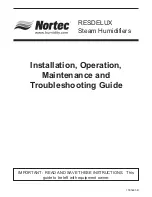
R
Features and
Benefits
WSHP-PRC003-EN
16
Hot Gas Reheat (option)
For space conditioning and climate con-
trol, Trane provides an accurate and
cost effective dehumidification control
through a hot gas reheat option. This
option is designed to accommodate
unit sizes 012, 036, 060 and 072 through
240.
With this reheat option, the return air
from the space is conditioned by the
air-to-refrigerant coil, then reheated by
the reheat coil to control not only the
space temperature, but to also reduce
the relative humidity of the space. The
moisture removal capability of a specif-
ic heat pump is determined by the units
latent capacity rating.
When operating in the reheat mode
(meaning the sensible temperature has
been met in the space), the humidistat
signals the reheat relay coil to energize,
allowing the high pressure refrigerant
gas to flow from the
(1)
compressor,
through the
(2)
reheat valve, into the
(3)
reversing valve, or through the
(4)
reheat coil for dehumidification
(See
Figure 19). A switching relay has been
provided for the reheat application to
adjust the blower motor from normal
operation to low speed when hot gas
reheat is energized.
Note: Trane places an air separation
space between the air-to-refrigerant
coil, and the reheat coil to allow for
maximum moisture removal.
Common Reheat Applications
The hot gas reheat option is designed
to support building applications requir-
ing fresh-air ventilation units delivering
unconditioned-air directly to the space.
It also provides dehumidification to
large latent load spaces such as audito-
riums, theaters and classrooms, or any-
where humidity control is a problem.
Proper Hot Gas Design
The factory installed hot gas reheat
option is only available with Deluxe or
ZN524 controls packages.
A high static blower motor option will
be required to support the hot gas
reheat option for the 1/2 through 5 ton
equipment.
Water regulating valves should not be
used with the hot gas reheat option.
Trane places a thermal expansion valve
on all water-source heat pumps, as well
as ground-source heat pumps, to regu-
late refrigerant flow vs. water flow,
making the heat pump more efficient to
run.
Water-source heat pumps with hot gas
reheat should not be used as a make-
up air unit.
Figure 19: Hot gas reheat heat pump option.













































